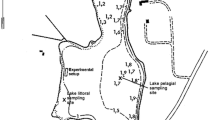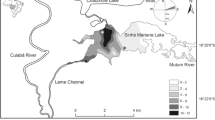Abstract
Macrophyte growth was studied in two enclosure types (gauze and polythene) in a homogeneousPotamogeton pectinatus bed in Lake Veluwe (The Netherlands). The gauze was expected to allow for sufficient exchange with the lake to maintain similar seston densities, the polythene was expected to exclude fish activity and most water exchange. Polythene enclosures held higher totalP. pectinatus biomass (ash-free dry weight, AFDW) than the lake, gauze enclosures were intermediate. The enclosures had a higher abundance of other macrophyte species (Chara sp.,Potamogeton pusillus) than the lake. Seston ash content was not but seston AFDW, periphyton ash content and AFDW were lower in polythene than in gauze enclosures. The difference in plant biomass between gauze and polythene may be attributed to a difference in periphyton density and in seston AFDW due to zooplankton grazing (Rotatoria andDaphnia densities were higher in polythene enclosures). Since seston and periphyton AFDW and ash content were similar in lake and gauze enclosures, the intermediate macrophyte biomass in the gauze enclosures may be explained by reduced wave action and mechanical stress. Alternatively, phytoplankton inhibition by allelopathic excretions from the macrophytes may have caused the high macrophyte biomass in the polythene, and an absence of sediment-disturbing fish the intermediate biomass in the gauze enclosures. Creation of sheltered areas may favour macrophyte growth through both mechanisms and we conclude that this can be an important tool in littoral biomanipulation.
Similar content being viewed by others
References
Anderson, M. G., 1978. Distribution and production of Sago Pondweed (Potamogeton pectinatus L.) on a northern prairie marsh. Ecology 59: 154–160.
Andersson, G., H. Berggren, G. Cronberg & C. Gelin, 1978. Effects of planktivorous and benthivorous fish on organisms and water chemistry in eutrophic lakes. Hydrobiologia 59: 9–15.
Bloesch, J., P. Bossard, H. Bührer, H. R. Bürgi & U. Uehlinger, 1988. Can results from limnocorral experiments be transferred to in situ conditions? (Biomanipulation in limnocorrals VI). Verh. int. Ver. Limnol. 23: 762–763.
Brabrand, Å., B. Faafeng & J. P. M. Nilssen, 1987. Pelagic predators and interfering algae: stabilizing factors in temperate eutrophic lakes. Arch. Hydrobiol. 110: 533–552.
Carpenter, S. R., J. F. Kitchell & J. R. Hodgson, 1985. Cascading trophic interactions and lake productivity. BioScience 35: 634–639.
Duarte, C. M. & J. Kalff, 1988. Influence of lake morphometry on the response of submerged macrophytes to sediment fertilization. Can. J. Fish. aquat. Sci. 45: 216–221.
Godmaire, H. & D. Planas, 1983. Potential effect ofMyriophyllum spicatum on the primary production of phytoplankton. In R. G. Wetzel (ed.), Periphyton of freshwater ecosystems. Junk, The Hague: 227–233.
Hosper, S. H., 1989. Biomanipulation, new perspectives for restoration of shallow eutrophic lakes in The Netherlands. Hydrobiol. Bull. 23: 5–10.
Jupp, B. P. & D. H. N. Spence, 1977. Limitations of macrophytes in a eutrophic lake, Loch Leven. II. Wave action, sediments and waterfowl grazing. J. Ecol. 65: 431–446.
Kautsky, L., 1987. Life-cycles of three populations ofPotamogeton pectinatus L. at different degrees of wave exposure in the Askö area, northern Baltic proper. Aquat. Bot. 27: 177–186.
Keddy, P. A., 1982. Quantifying within-lake gradients of wave energy: interrelationships of wave energy, substrate particle size and shoreline plants in Axe Lake, Ontario. Aquat. Bot. 14: 41–58.
Kuiper, J., 1977. Development of North Sea coastal plankton communities in separate plastic bags under identical conditions. Mar. Biol. 44: 97–107.
Lack, T. W. & J. W. G. Lund, 1974. Observations on the phytoplankton of Blelham Tarn, English Lake District. I. The experimental tubes. Freshwat. Biol. 4: 399–415.
Leah, R. T., B. Moss & D. E. Forrest, 1978. Experiments with large enclosures in a fertile, shallow, brackish lake, Hickling Broad, Norfolk, United Kingdom. Int. Revue ges. Hydrobiol. 63: 291–310.
Lund, J. W. G., 1972. Preliminary observations on the use of large experimental tubes in lakes. Verh. int. Ver. Limnol. 18: 71–77.
Lynch, M., 1979. Predation, competition, and zooplankton community structure: an experimental study. Limnol. Oceanogr. 24: 253–272.
Lynch, M. & J. Shapiro, 1981. Predation, enrichment, and phytoplankton community structure. Limnol. Oceanogr. 26: 86–102.
McCauley, E. & F. Briand, 1979. Zooplankton grazing and phytoplankton species richness: field tests of the predation hypothesis. Limnol. Oceanogr. 24: 243–252.
McQueen, D. J. & J. R. Post, 1988. Limnocorral studies of cascading trophic events. Verh. int. Ver. Limnol. 23: 729–747.
Moss, B. & R. T. Leah, 1982. Changes in the ecosystem of a guanotrophic and brackish shallow lake in Eastern England: potential problems in its restoration. Int. Revue ges. Hydrobiol. 67: 625–659.
Norusis, M. J., 1986. SPSS-PC+ manual. SPSS Inc., Chicago, USA, 559 pp.
Phillips, G. L., D. Eminson & B. Moss, 1978. A mechanism to account for macrophyte decline in progressively eutrophicated freshwaters. Aquat. Bot. 4: 103–126.
Post, J. R. & D. J. McQueen, 1987. The impact of planktivorous fish on the structure of a plankton community. Freshwat. Biol. 17: 79–89.
Riemann, B. & M. Søndergaard, 1986. Regulation of bacterial secondary production in two eutrophic lakes and in experimental enclosures. J. Plankton Res. 8: 519–536.
Shapiro, J. & D. W. Wright, 1984. Lake restoration by biomanipulation: Round Lake, Minnesota, the first two years. Freshwat. Biol. 14: 371–383.
Steel, R. G. D. & J. H. Torrie, 1980. Principles and procedures of statistics, a biometrical approach. 2nd edition. McGraw Hill, New York, 633 pp.
Ten Winkel, E. H. & J. T. Meulemans, 1984. Effects of fish upon submerged vegetation. Hydrobiol. Bull. 18: 157–158.
Author information
Authors and Affiliations
Rights and permissions
About this article
Cite this article
Vermaat, J.E., Hootsmans, M.J.M. & van Dijk, G.M. Ecosystem development in different types of littoral enclosures. Hydrobiologia 200, 391–398 (1990). https://doi.org/10.1007/BF02530356
Issue Date:
DOI: https://doi.org/10.1007/BF02530356




